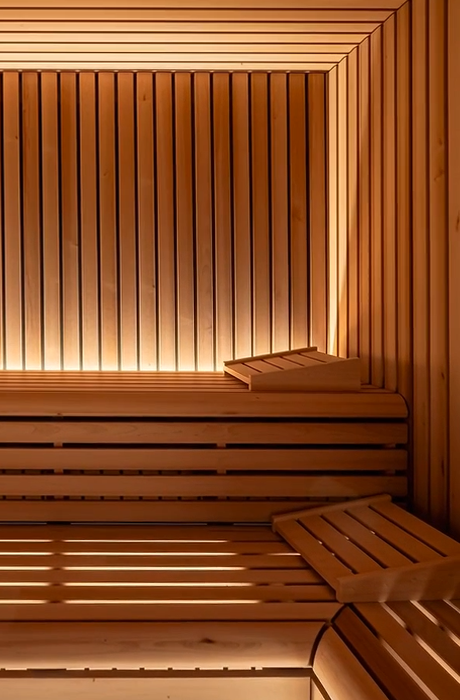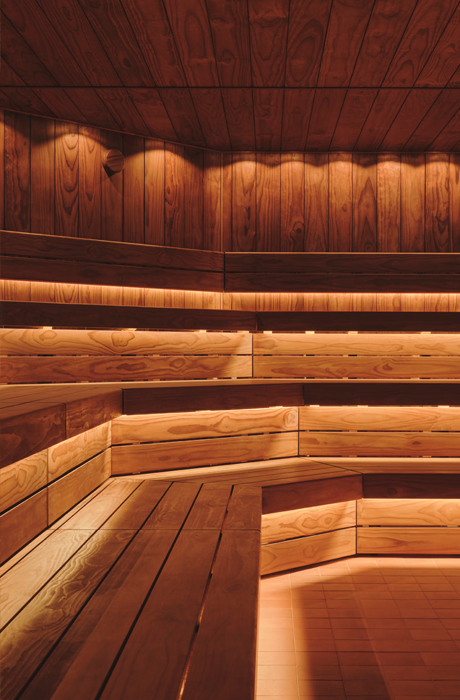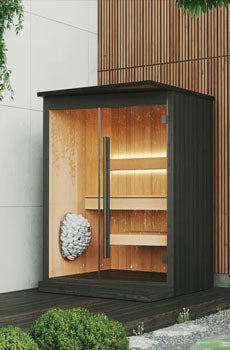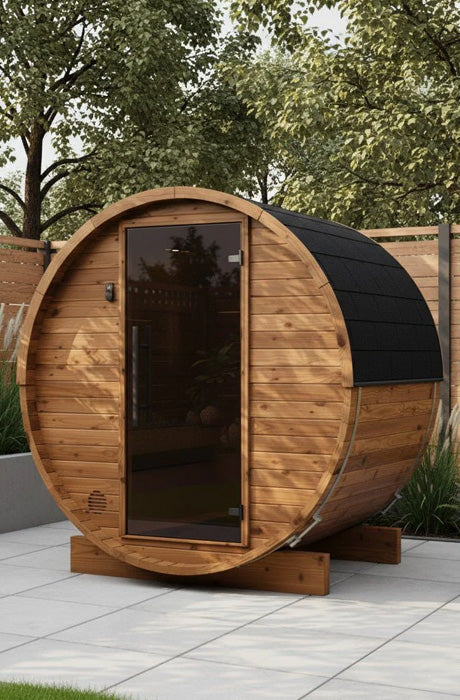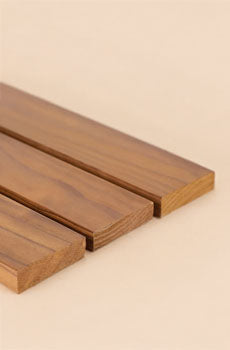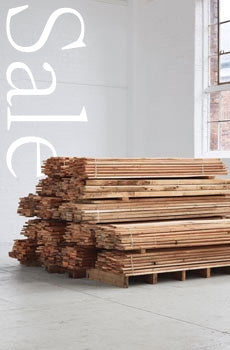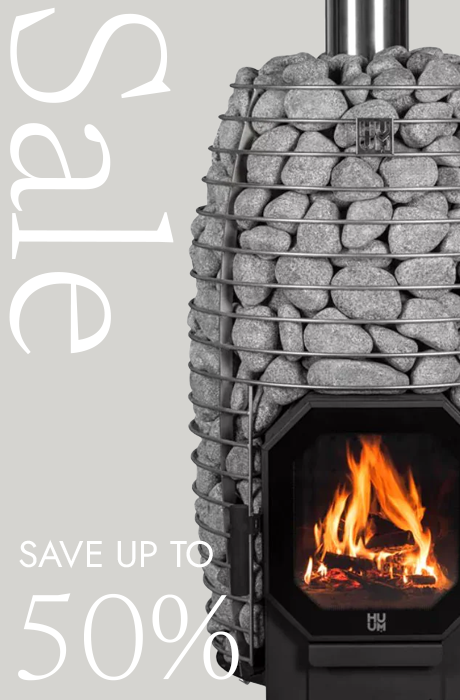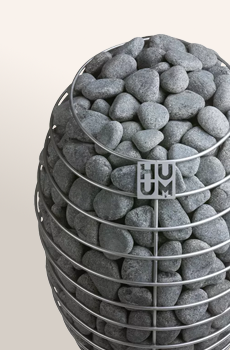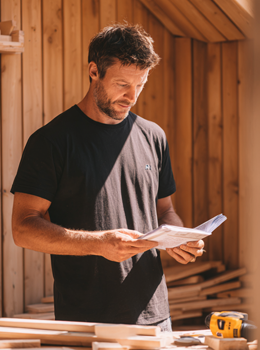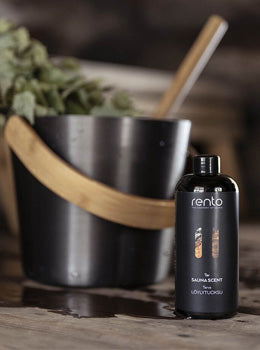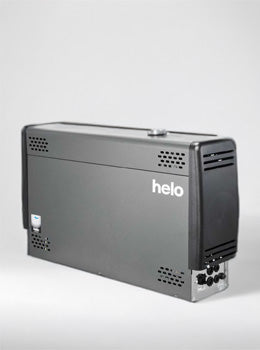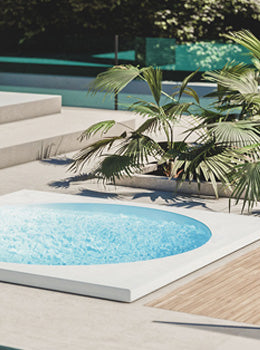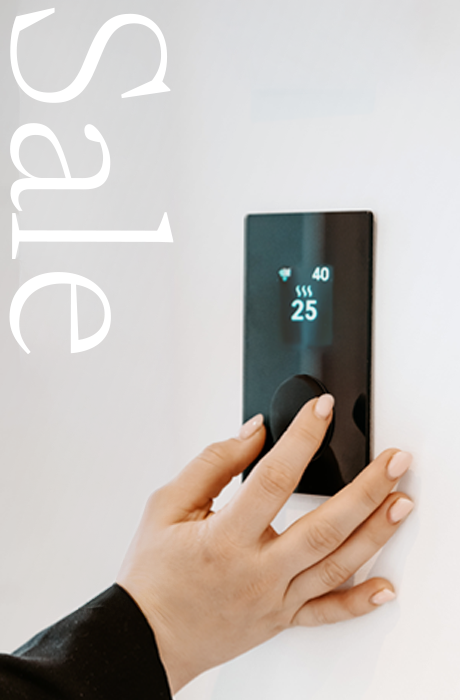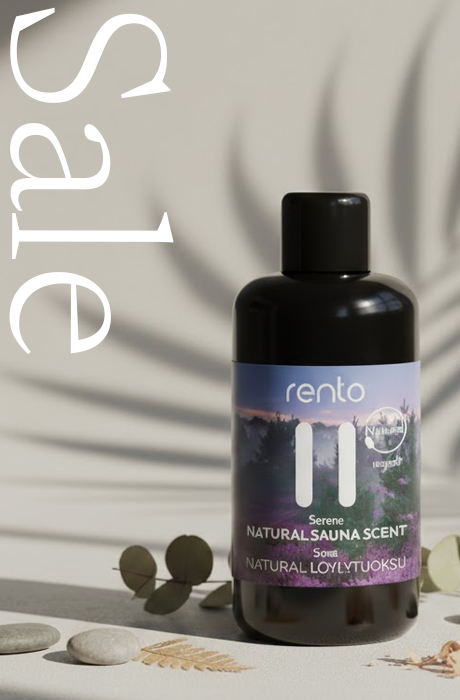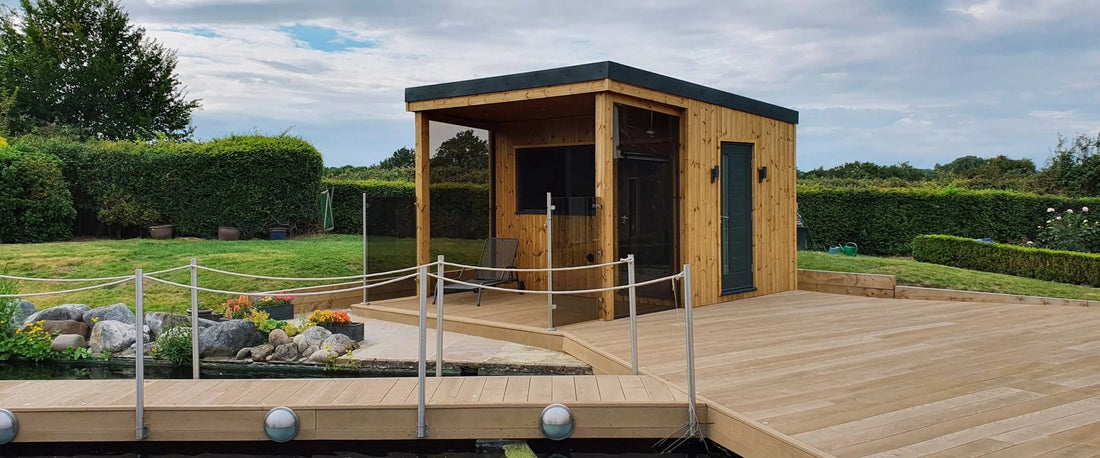
Outdoor and garden Finnish saunas - An interview with Technical Director Max Newport

It's National Gardening Week 2021 and a great time to get out and benefit from our own outdoor spaces if we are lucky enough to have them. The annual week is a time when greenery and outdoor spaces around the country are celebrated and this year the Royal Horticultural Society urges people to get their daily dose of vitamin G, “G” standing for “green”. Since its inception in 2012 there’s been a different theme each year and this year the RHS is celebrating the positive impact that plants and gardens have for our wellbeing, backed up by scientific evidence.
To join in with this year’s theme, we are celebrating outdoor and garden saunas. These quaint saunas combine the physical and mental advantages of nature and the Finnish art of “löyly”, the steam that evaporates from the heater stones when pouring water on them. Connecting with nature is an important aspect of the authentic sauna experience and many saunas in Finland are located by a lake or a forest. As people have been spending more time at home amidst national lockdowns, the interest in gardens and creating beautiful outdoor spaces with easy access has increased. Following this trend, the sauna industry has also seen growing interest in garden saunas.
Gardens can have broad positive effects for our wellbeing. Relaxation and stress reduction are recognised as two major health benefits resulting from spending time in gardens [1]. Green and open spaces have also been linked to self-reported improvements in overall mental and physical wellbeing [2] through improving social relationships and a sense of belonging [3]. These results are similar to some of the health benefits of sauna bathing. People have reported that one of the main reasons they use the sauna frequently is socialisation [4].
Other health benefits of regular sauna sessions include stress reduction, cardiovascular health and sleep improvement. Creating unique green spaces is beneficial for our mind and body. Even though traditional, rustic log saunas are still the most common outdoor saunas in Finland, the demand for smaller garden saunas continues to grow in the country. The sauna industry keeps developing and there are multiple unique options to suit different types of outdoor spaces. Being separated from the house, an outdoor sauna provides the opportunity to connect with nature and creates its own getaway from everyday life stresses. Fortunately, UK gardens and outdoor spaces can usually be easily adapted to accommodate Finnish saunas, whether they are situated in purpose-built sheds or log cabins, or even into existing converted garden buildings. We interviewed our Technical Director, Max Newport about the essentials to consider when adding a truly special and tranquil addition to your garden whatever the weather...
Can you tell me the most important things to consider when choosing an outdoor sauna?
“The first thing to take a look at are planning restrictions. If you are keen on a sauna cabin for example you’ll have to work out if the cabin build would be accepted as a permitted development in your area. We advise that the best thing is to check the planning portal regarding outbuildings to see whether the size and location of your cabin would require planning permission. Does the cabin require electricity, water or drainage? This can help sway where you would consider putting the cabin if any of these answers are yes. When it comes to heater choice- high frequency of use, convenience, cost and smoke controlled zones like cities may steer someone towards an electrically heated sauna. The romance, ritual and esoteric quality of the heat and bathing experience might sway purists to a wood-burning sauna. When considering foundations, it entirely depends on what solution you go for. If it’s a modular kit cabin they’ll generally have a timber base on them and the foundation will depend on what the base is made of. They may require piles to keep them clear of the ground so that the base doesn’t have permanent contact with the ground. Another quick and low cost, less intrusive solution that we love to offer is ground screws.
It’s essential to ensure that you specify your cabin to allow all the bathers to sit above the top of the heater in a room with a flat ceiling or one that doesn't create an atmosphere where all the heat and steam sits up too high in the room. The Finnish word ´löyly´ is the name for the evaporating hot steam that rises from the ´kiuas´ (stove) after water has been carefully thrown on top of the sauna stones. It is precisely this löyly that is fundamental for the best authentic Finnish sauna bathing experience.
Factor roughly 600mm x 600mm of bench space for every bather you want to accommodate. Consider specifying the top bench long enough to allow someone to lie down flat too and bear in mind that the heater and its safety clearances may require a large proportion of the available space. Wood-burning sauna heaters can have some pretty massive safety distance requirements to combustible materials so it might be worth thinking about heat shielding to maximise your space. Also, make sure your heater has sufficient power to heat the computational volume of your sauna. This will include the loss factor of any glazing and uninsulated walls/ceiling. Be honest with yourself about the majority use case - how often are you really going to host 4+ people in your sauna? People heat up at different rates in a sauna so you typically won't all bath at once with a larger group of people. An outdoor sauna allows you to enjoy your garden at more times of the day and year. When you've been bathing at 90 degrees C, you don't care if it's dark, below zero or snowing outside! Consider a space to cool off and relax on loungers or other seating between bathing intervals. A cold plunge pool or outdoor shower is great for your health and provides a hefty endorphin rush! A barbeque and outdoor drinks cooler can help satisfy your hunger and refresh your thirst after a sauna. Consider windows from your sauna - a sauna with a view adds a nice focal point whilst you reflect and relax.”

If I’m limited on outdoor space what are my options?
“If you're really limited, then you’ll probably need to go for an outdoor bespoke sauna installation rather than a cabin or modular cabin kit. It’ll allow you to maximise the available internal space rather than rely on finding or adapting something to fit.”

What are the choices for the heat source? (what do I need in terms of running electric cables outside, wood-burning stoves, plumbing etc)?
“An electric sauna heater will likely require a significant cable running from your incoming supply or mainboard/consumer unit inside your house. Does your house have enough capacity? If you have a 100amp supply to your house and you also have an electric cooker, a power shower and a 9kW sauna heater, then you could overload your supply if all were on concurrently. You may need to safeguard your supply by ensuring multiple appliances cannot be on at the same time by means of priority switching with contactors. You should also consider the route of the supply cable. How easy will it be to run a cable from the supply to the cabin in a way that you are happy with it? Running a cable out of sight through a finished house and garden is difficult without being intrusive and digging/removing things. Your electrician will be able to help you with all of this, just make sure to supply them with all of the technical documents and specifications of the heater that you are interested in and sauna lighting that might be required. When it comes to wood-burning stoves it’s not just the heater you need to consider because you need to buy a flue kit and think about heat shielding and installation. You might do a like for like comparison of heaters and think there’s not much price difference when going for a wood-burning stove over an electric one but actually there’s more cost because of all the sundries.”

What impact will this have on my fuel bills? Is there an eco or more energy-efficient way of installing an outdoor sauna? (solar powered)?
“Electric sauna heater fuel costs aren’t too bad at all. The max power you can typically get from a single-phase sauna heater is 9kw. Most electric sauna heaters are thermostatically controlled, so they are on pretty much solidly for the first hour to heat up the sauna then they turn on and off depending on how efficiently insulated your sauna space is. If your sauna session is 2-3 hours the worst case is 27kw hours - so probably less than £4 in electrical costs over 3 hours - particularly considering that your heater won’t actually be on constantly once it’s reached a temperature you are happy with. Think about what building materials if you have a particular interest in your carbon footprint. Consider natural fibre insulation with a good lifespan and also consider the design life of the sauna. If you build something with high-quality materials and made to last for a long time it’s going to be much more sustainable compared to something that’s only going to last a few years.”

What is the difference between infrared and traditional? (it’s often reported that infrared is best)?!
“You can’t call an infrared treatment room a sauna. They shouldn’t really be labelled the same way. There are health benefits to far-infrared but there’s actually more of that good energy in a traditional Finnish sauna once everything has heated up.”

What are the best materials to choose? (why are saunas always timber)?
“Traditionally, it was the most prominent building material in Finland. Timber doesn’t have a high specific heat capacity and less dense timbers don’t feel too hot when you lay against them. For the exterior, it’s good to use highly durable timbers like cedar which has a naturally high rot and pest resistance. Spruce and larch are great outside as well - there are lots of timber usage websites out there which tell you what’s best for use outside.”

Are there specific timbers that are most suited to heat? Does the timber need to be treated?
“Yes and yes. Some attractive wood is less stable in heat - such as aspen. However, when it’s thermally treated it becomes much more stable. It retains the low-density benefits of aspen but with a lovely dark, richer colour and toasted aroma from the thermo treatment process. I’d recommend treating the external timber to maintain the colour and prevent mould, mildew, algae and rot. Internally, we treat all of our timber with white mineral oil or paraffin oil on both sides to help seal the wood. It’s the same ingredient that’s in baby oil so it’s skin safe and it makes the sauna easier to clean.”

What will it cost? (an approximation from lowest to highest would be good as what you’d get for that)
“Our entry-level cabin kits which are made in Finland are between £7000-£8000 depending on your chosen heater. You can probably add another £2000 for installation. However, if you are practical, know what you are doing and get all the materials to build one yourself to build a small, simple Finnish sauna you could get it all done for around £5000 worth of materials. There’s a bar we don’t like to stoop below in terms of the quality of the experience. Some of our cabins can be up to £30,000 with installation and our bespoke installations can be more expensive. You’ve got to consider design time and skilled installers. Some of the installs we work on are effectively an extension of a clients house. Some of our residential bespoke installations have come in at north of £50,000. For those with particularly opulent tastes, we’ve worked on projects £100,000 plus.”

How important is it to alternate between hot and cold? Is it worth installing a cold shower/plunge pool too?
“This is super important and very much how it’s done in Finland. The experience isn’t complete without such extremes. It’s a hugely pleasurable, endorphin rush and there’s a number of sauna health benefits based around the regular alternating between hot and cold during a session. Our clients tell us of improved sleep and reduced stress once they start using their setups regularly.”

References:
[1] Buck, D. (2016) ‘Gardens and Health: Implications for policy and practice.’ The King’s Fund. Pp.1-65. Available at: https://www.kingsfund.org.uk/sites/default/files/field/field_publication_file/Gardens_and_health.pdf.
[2] Barton, J & Pretty, J (2010). ‘What is the best dose of nature and green exercise for improving mental health? A multi-study analysis.’ Environmental Science & Technology, Vol 44 (10), pp. 3947–55.
[3] Pinder, R; Kessel, A; Green, J & Grundy, C (2009). ‘Exploring perceptions of health and the environment: a qualitative study of Thames Chase Community Forest’. Health & Place, Vol 15 (1), pp. 349–56.
[4] Hussain, J; Greaves, R; and Cohen, M (2019) ‘A hot topic for health: Results of the Global Sauna Survey’ Complementary Therapies in Medicine (44) pp. 223-234. Available at: https://www-sciencedirect-com.ezphost.dur.ac.uk/science/article/pii/S0965229919300998?via%3Dihub.